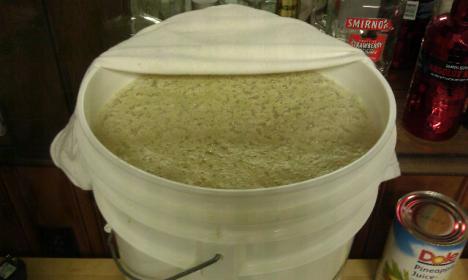Open fermentation should be practised with perfect timing in regards to when to bottle. When the beer stops fermenting, no CO2 is produced, therefore exposing your beer to oxygen. You can either pay close attention to the specific gravity, or if you don't feel confident in this and/or don't want to waste a lot of beer, you can replace the lid with a few days to go in the ferment. This should give you the characteristics of a beer not brewed under pressure, but with the security of CO2 to protect your brew from spoiling.
Agreed, timing is key. In a closed container, waiting an extra day or two to rack is not a big deal. With an open ferment, this could be a problem. You really have to rack as soon as its ready.
Its really ideal to use a top-cropping strain for this. All strains will produce some krausen, as in some foam, but only true top-croppers will actually leave a sheet of yeast cake floating on the surface. As the beer ferments, the look and texture of the krausen changes. You can tell when the beer is ready to rack by how the yeast cake on top looks. It'll go from foamy to very gummy and 'cake' looking. If you wait too long, it will drop and then you will lose the opportunity to harvest it and also put the brew at risk for oxidization or contamination.
With that said, the CO2 barrier is not the only defense. The yeast layer on top also provides some protection. A strong colony of yeast is interested in protecting its food and will out-compete other organisms when it is strong.
I always have to do a secondary with open ferments though. That perfect timing to rack is usually a couple points away from complete attenuation, and it'll need a bit more time for everything to fall out of solution including a cold crash.
When ready, I will harvest the yeast on top and immediately rack to secondary thereafter. My primaries finish in 3-4 days now. Even at fairly high gravities.
But again, in case I haven't said it enough. There are two highly important factors to successful open fermentation.
#1 - Use a strain that performs well under this condition and produces a nice yeast layer for top cropping. My favorites are:
* WLP 001 (cal ale) - this is a seriously reliable open fermenter, my fav
* Kolsch - Wyeast or White Labs - I believe most german strains are top-croppers though
* London Ale III - surprisingly, there are many english strains that are terrible for this and some that are perfect. This is a good one.
* WLP 500, WLP 530, WLP 550, WLP 575 - These Belgian strains work well
#2 - You really need a shallow vessel as a fermenter (at least a 1:1 ratio of height to diameter). Buckets are really not adequate for getting the full benefits of open fermentation. Fine for experimentation, but not for continued use. I have nothing but amazing results with this technique again and again and so much of that is due to the fermenter.








